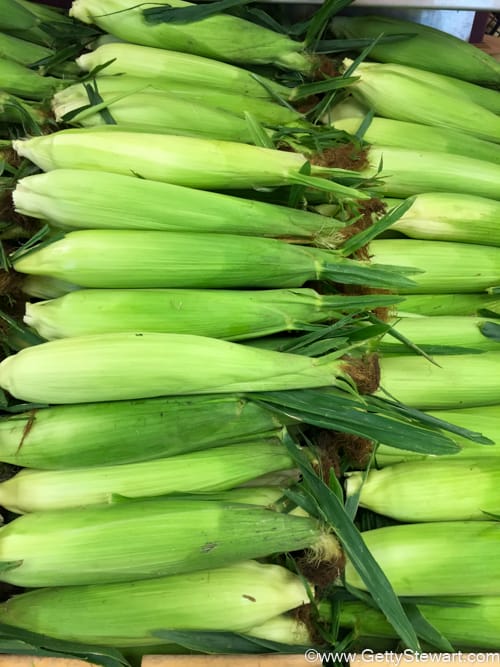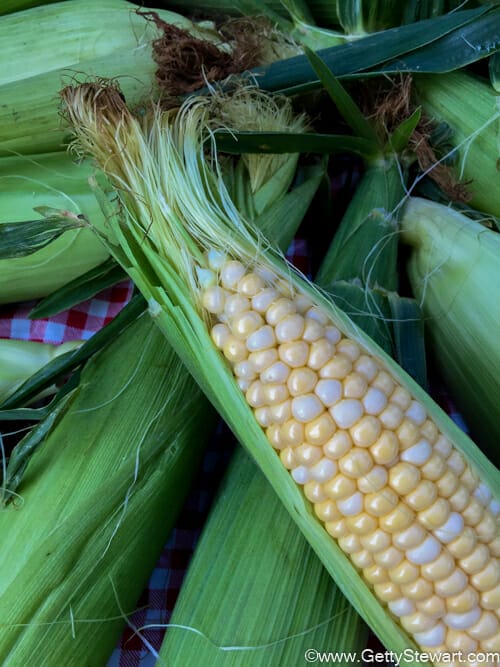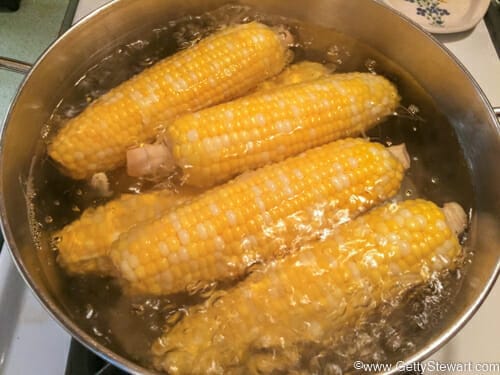How to Pick, Store and Boil Corn on the Cob
Here’s a primer on how to pick, store and boil corn on the cob to help you enjoy corn on the cob to the fullest.
How to Pick Fresh Corn
If possible, go to a local market or farmer where you can be assured the corn has been freshly picked.
Look for cobs that are medium sized compared to those around, small cobs may be immature and big ones may be overripe – go for middle of the pack. Of the medium sized cobs, choose the ones that feel the heaviest.
Look for leaves that are tight to the cob and a nice green color.
Feel the cob for uniform rows of kernels. If the cob feels irregular with gaps, not all the kernels will have filled out.
Look for silk (the tassle at the top) that is light brown and still green at the top of the cob. Silk that is very dark and dry throughout is old.
If the seller is okay with you doing this, pull back a bit of the leaves and have a peak at the kernels. You want bright, plump looking kernels that are ready to burst.
By the way, did you know some of the sweetest corn varieties are all yellow – not bi-color or peaches and cream? It’s true, both color varieties come in super sweet versions – ask your grower or supplier more about the variety they’re selling.
How to Store Fresh Corn on the Cob
Store corn in its husk. As convenient as those husking bins at the store are, those cobs will stay fresher and store longer if you keep the husk on. The husk offers perfect protection for the corn by keeping the moisture level just right.
Place corn in a paper bag and store in the refrigerator. The cool temp of the fridge will slow down the conversion of sugar to starch and keep your corn tasting sweet longer.
Store no longer than 4 days max, although some of today’s varieties may last a day or two longer without loosing sweetness.
How to Boil Corn on the Cob
- Get the freshest corn possible and husk it just before ready to boil.
- Bring a large pot of water to boil. Do NOT salt the water. Salt will make the corn kernels tough.
- Boil for 4 to 6 minutes depending on the size of cob and how crisp and juicy or soft and tender you want your corn. The longer you boil it, the softer the corn will be and the less crisp and juicy. Our parents used to boil corn for much longer, but today’s varieties are so sweet and tender, they need much less time than corn from 10 years ago.
- Use tongs to remove the cobs from the boiling water. Serve and enjoy.
If you have too much corn on the cob, remove it from the husk and freeze or dehydrate it.
Why Is it Important to Cook Corn on the Cob Right Away?
What’s the big deal about cooking corn on the cob right away? It’s all about the sugar and getting the sweetest corn possible. The minute corn is picked, the sugar in the corn starts to turn to starch. How quickly this happens depends on the variety of corn and storage conditions. Heirloom corn (old world sweet corn) turns to starch very quickly. This is what our grand-parents and their parents ate and they knew that you didn’t pick corn until you were going to eat it. That knowledge and tradition has been passed down to us.
However, since the 1950’s sweet corn has seen a lot of changes. With cross-pollination, gardeners and commercial sweet corn growers have developed hybrids that slow the process of sugar to starch conversion. As a result, we now have a much longer range for cooking sweet corn, sometimes up to six days. But, knowing what variety you’re getting and how long you have is pretty tricky.
The prevailing wisdom is still to cook your corn as soon as possible, especially if you don’t know the variety or how long it’s been in transit or sitting on the shelf.
What About Pre-Husked Corn on the Cob?
A lot of grocery stores are now selling trays of pre-husked corn wrapped with plastic. Being curious, I bought a tray outside of regular corn season. It felt weird eating a cob of corn in March and I was certain it would be disappointing. But, surprisingly, while it didn’t quite measure up to local corn, it was pretty good. It’s another sign that sweet corn has changed from when I was a little girl on the farm and ate corn every lunch and dinner for two weeks solid – enough corn to satisfy you for the year!
While the flavor of this plastic wrapped corn is good, I’m sad to see all that packaging. Styrofoam trays and plastic wrap adds a lot of garbage to a food that comes perfectly wrapped naturally.
My preference is still for local, seasonal corn in the husk.
Who knew that I was such a traditionalist! Somehow, corn on the cob will always be an August food in my mind. How about you? Do you have specific corn preferences?
Sign up to get articles by Getty delivered to your inbox. You’ll get recipes, practical tips and great food information like this. Getty is a Professional Home Economist, speaker and writer putting good food on tables and agendas. She is the author of Manitoba’s best-selling Prairie Fruit Cookbook, Founder of Fruit Share, a mom and veggie gardener.





